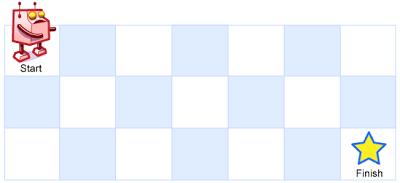A robot is located at the top-left corner of a m x n grid (marked ‘Start’ in the diagram below).
The robot can only move either down or right at any point in time. The robot is trying to reach the bottom-right corner of the grid (marked ‘Finish’ in the diagram below).
How many possible unique paths are there?
Above is a 7 x 3 grid. How many possible unique paths are there?
Example 1:
Input: m = 3, n = 2
Output: 3
Explanation:
From the top-left corner, there are a total of 3 ways to reach the bottom-right corner:
1. Right -> Right -> Down
2. Right -> Down -> Right
3. Down -> Right -> Right
Example 2:
Input: m = 7, n = 3
Output: 28
Constraints:
1 <= m, n <= 100- It’s guaranteed that the answer will be less than or equal to
2 * 10 ^ 9.
Runtime: 0 ms, faster than 100.00% of C++ online submissions for Unique Paths.
Memory Usage: 6.5 MB, less than 100.00% of C++ online submissions for Unique Paths.
class Solution {public:int uniquePaths(int m, int n) {if (m == 1 || n == 1) {return 1;}vector<vector<int>> dp(m, vector<int>(n, 1));for (int i = 1; i < m; i++) {for (int j = 1; j < n; j++) {dp[i][j] = dp[i - 1][j] + dp[i][j - 1];}}return dp[m - 1][n - 1];}};
Runtime: 4 ms, faster than 8.87% of C++ online submissions for Unique Paths.
Memory Usage: 6 MB, less than 100.00% of C++ online submissions for Unique Paths.
class Solution {public:int uniquePaths(int m, int n) {vector<int> pre(n, 1);vector<int> cur(n, 1);for (int i = 1; i < m; i++) {for (int j = 1; j < n; j++) {cur[j] = pre[j] + cur[j - 1];}swap(cur, pre);}return pre[n - 1];}};
Runtime: 0 ms, faster than 100.00% of C++ online submissions for Unique Paths.
Memory Usage: 6.1 MB, less than 100.00% of C++ online submissions for Unique Paths.
class Solution {
public:
int uniquePaths(int m, int n) {
vector<int> cur(n, 1);
for (int i = 1; i < m; i++) {
for (int j = 1; j < n; j++) {
cur[j] += cur[j - 1];
}
}
return cur[n - 1];
}
};

